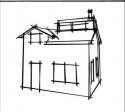A few years ago I topped off my 2x4 flat pan with sap at the end of the season and covered it for a couple months. Opened it up and everything lifted off as well as any vinegar solution I have ever used. I may do that again this year with my current rig.














 Reply With Quote
Reply With Quote


